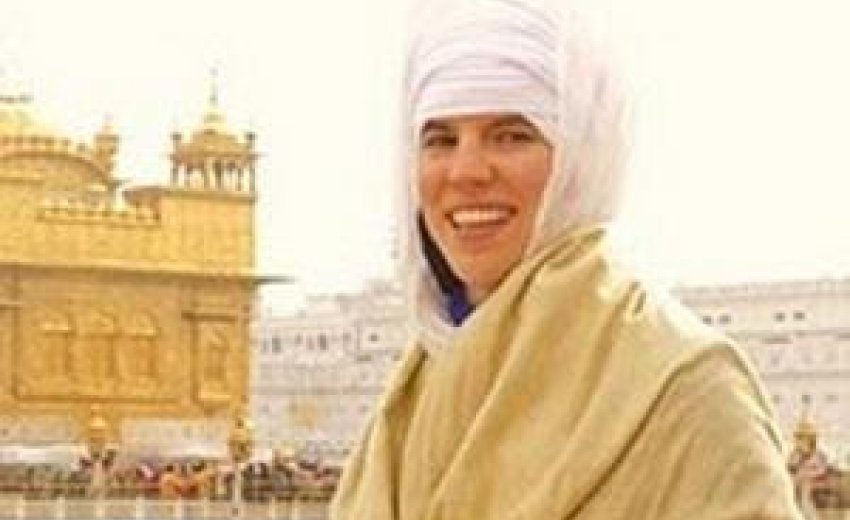 Last Friday, Bibi Harvinder Kaur Khalsa, formerly known as Alexandra Aitken who used to be in the circle of celebrities and wealthy people but now an Amritdhari Singhni, visited Singh Sabha Gurdwara, Cross Road, Coventry, to do a talk at the weekly inspirational class that is held every Friday, 7pm to 8.30pm.
Last Friday, Bibi Harvinder Kaur Khalsa, formerly known as Alexandra Aitken who used to be in the circle of celebrities and wealthy people but now an Amritdhari Singhni, visited Singh Sabha Gurdwara, Cross Road, Coventry, to do a talk at the weekly inspirational class that is held every Friday, 7pm to 8.30pm.
Bibi jee was accompanied by husband, Veer Inderjot Singh jee. Both had come from Amritsar this month. With Guru Sahib's kirpaa there was a fantastic turn out of Sangat, which included people of all ages.
Bibi Ji definitely had a radiating and peaceful presence. She told the Sangat the she was nervous to speak as this was her first talk. However, despite her initial nerves, Bibi jee presence, talk and way of communicating Gurmat in a simple and practical manner inspired all the Sangat. She soon became comfortable speaking on the stage and share answers to questions that people had asked. Whilst on the stage, she had a sarbloh baattaa (iron bowl) filled with water to drink from.
She started off to explain how she came into Sikhi. Her first encounter with Sikhi was when she visited a Sikh's house and they had keertan playing in the house. Hearing the keertan she became mesmerized and fell in love with sound current of Gurbani. She went on trip to India, and was due to go back to the USA, however, her visa expired. This resulted in a further 40 days stay in India. During these 40 days she had a life changing experience and got the opportunity to further her Sikhi and visit Amritsar.
 One day she wanted to buy some thermal underwear because she was feeling cold. She went to a Sikh shop. When she asked for underwear to keep her warm, the Sikh shopkeeper gave her a Kachhera (traditional Sikh shorts), and told her to wear them. Although she found them odd to look at, she decided to buy them and try them on. She said, once she wore the Kachhera, she never turned back. Bibi jee described the spiritual and health benefits of wearing the Kachhera to the Sangat. As well as being comfortable to wear and looking modest, the Kachhera that goes up to knee height and is tight around the knees, traps Calcium in the body which helps to weight control/loss and the design maintains a constant body temperature. She said that she told her Yoga teacher off for not telling her before that Sikhs wear the Kachhera.
One day she wanted to buy some thermal underwear because she was feeling cold. She went to a Sikh shop. When she asked for underwear to keep her warm, the Sikh shopkeeper gave her a Kachhera (traditional Sikh shorts), and told her to wear them. Although she found them odd to look at, she decided to buy them and try them on. She said, once she wore the Kachhera, she never turned back. Bibi jee described the spiritual and health benefits of wearing the Kachhera to the Sangat. As well as being comfortable to wear and looking modest, the Kachhera that goes up to knee height and is tight around the knees, traps Calcium in the body which helps to weight control/loss and the design maintains a constant body temperature. She said that she told her Yoga teacher off for not telling her before that Sikhs wear the Kachhera.
Bibi Jee told the Sangat that the Sikhs are so blessed to be given such a wonderful religion, such an amazing Rehat (code of conduct) and practical message that Sikhs have not done enough to share it with others. She urged all the Sangat to wear Kachhere and experience the spiritual and health benefits of it.
 She then went on to explain why she wears Baanaa (traditional Sikh attire). She said that when she saw her husband for the first time, she saw Guru Gobind Singh jee's image in him. She said that her other white Sikh friends would not marry a man that didn't wear full Baanaa all the time because the Baanaa represents total submission, devotion and acceptance of the Guru. She explained how she couldn't understand why someone would want to cut their beard or shave their hair and lose their beauty. The physical appearance and clothes of an individual manifests their personality and inner self and therefore an individual wearing Baanaa shows that he or she loves the Guru.
She then went on to explain why she wears Baanaa (traditional Sikh attire). She said that when she saw her husband for the first time, she saw Guru Gobind Singh jee's image in him. She said that her other white Sikh friends would not marry a man that didn't wear full Baanaa all the time because the Baanaa represents total submission, devotion and acceptance of the Guru. She explained how she couldn't understand why someone would want to cut their beard or shave their hair and lose their beauty. The physical appearance and clothes of an individual manifests their personality and inner self and therefore an individual wearing Baanaa shows that he or she loves the Guru.
She told the Sangat that she wears her Baanaa in full pride and that all Sikhs should wear Baanaa with pride and dignity and not shy away from it. Whilst describing the Baanaa, she explained the significance of the Kesh and Keski/Dastaar (turban). It was very uplifting to hear Bibi jee telling all the ladies in the Sangat that as Sikh women they should have their hair knot (jooraa) on the top of their head and it should be covered with a Dastaar. She described the spiritual, health and mental benefits of wearing a Dastaar and having one's jooraa on the top of the head. The way she described it was really positively received by the whole Sangat. She also told the ladies that they should ensure their husbands or children do not cut their beards. If a man is moody, irritable or has headaches, then a woman should check whether her son or husband has abused their Kesh by dyeing it, cutting it or trimming it. She said cutting Kesh is "a big no!" and that women must ensure it never happens in their house. She went further on to explain the importance of lady's hair and why women shouldn't shave, trim or color their hair.
 Near the end she explained the significance of keeping Sarbloh Rehat. Sarbloh means iron. It is a Khalsa tradition that Amrit, Langar, Parshaad and the daily food of a Sikh is prepared in a Sarbloh (pure iron utensils). In modern times, the observance of this tradition has been relaxed by Sikhs, however, a small number of Gursikhs have continued to practice the discipline of cooking and eating only from Sarbloh.
Near the end she explained the significance of keeping Sarbloh Rehat. Sarbloh means iron. It is a Khalsa tradition that Amrit, Langar, Parshaad and the daily food of a Sikh is prepared in a Sarbloh (pure iron utensils). In modern times, the observance of this tradition has been relaxed by Sikhs, however, a small number of Gursikhs have continued to practice the discipline of cooking and eating only from Sarbloh.
Bibi jee explained that her first gift from her husband was a Sarbloh Baattaa. She questioned the gift when receiving it. Being an inquistive person and not accepting anything until having done some research, she began researching reasons behind cooking and eating in Sarbloh. Her research from multiple sources, led her to the conclusion that cooking and eating in Sarbloh was a must and that as a Sikh we should be grateful to our Great Gurus for blessing us with such a tradition. She explained that the core of the earth is Sarbloh (iron), and by eating in Sarbloh one grounds their personality. If someone has scatty thoughts and struggles to remembering things (i.e. "is spaced out") then she recommended that those people cook and eat from Sarbloh. When one cooks food in Sarbloh and recites Gurbani or Naam, the vibrations multiply and so the spiritual benefit of eating in Sarbloh is also multiplied.

She reminded the Sangat that they are lucky to be born in the Sikh faith or at least have some sort of connection with the Guru and Gurdwara. She said she was not so lucky but is thankful that she found out. She urged the Sangat to play Gurbani keertan in their cars, homes, and workplaces so that other white people like herself can take advantage of this spiritual treasure. Even though she doesn't understand Gurmukhi or Gurbani at the moment, she said that the sound current of Gurbani itself heals and brings peace to the mind and soul. She said that Sikhs need to tell the world that the Gurbani and Naam is the cure for all diseases and that it has power to heal the mind, body and soul. She smiled and said "You have the cure, you have the medicine - and you need to share it with the world!"
It was a very inspirational talk. I haven't done justice to it in this short summary of the talk. Unfortunately there were no recordings, in accordance to Bibi Harvinder Kaur jee's wishes.
Dhan Hai Guru! Dhan Hai Teree Sikhee!

